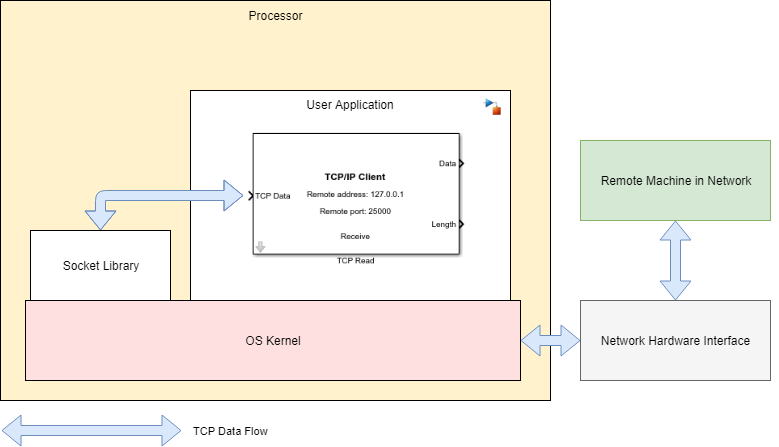TCP Read
Receive TCP/IP packets from remote host over TCP/IP network
Libraries:
SoC Blockset /
Processor I/O
Description
The TCP Read block receives a stream of TCP/IP packets from a remote host over a TCP/IP (Transmission Control Protocol/Internet Protocol) network.
Ports
Input
This message port receives TCP/IP packets, as messages, from a connected IO Data Source block. The messages process when the Task Manager block triggers task containing the TCP Read block. For more information on messages, see Messages.
Note
This input is used only during simulation. and does nothing in code generation and external mode simulation.
Data Types: SoCData
Output
Output TCP/IP packets received from remote host, returned as a numeric vector. The size and data type of this output is same as the size and data type of the input message.
Data Types: single | double | int8 | int16 | int32 | uint8 | uint16 | uint32
Length of output TCP/IP packets returned on the output data port.
Data Types: uint32
Parameters
To configure this block as a TCP/IP client or server, set this parameter to
Client or Server,
respectively.
When you set this parameter to Client, you must provide
the remote IP address and remote IP port number of the TCP/IP server from which you want
to receive TCP/IP packets. Specify this information by using the Remote
address and Remote port parameters.
When you set this parameter to Server, you must provide
the local IP port number, which acts as the listening port of the TCP/IP server running
in the hardware. Specify this information using the Local port
parameter. When you set this parameter to Server, you can
only connect to one client at a time.
Specify the IP address of remote server from which you want to receive TCP/IP packets.
Dependencies
To enable this parameter, set the Network role parameter to
Client.
Specify the port number of the remote server from which you want to receive TCP/IP packets.
Dependencies
To enable this parameter, set the Network role parameter to
Client.
Specify the port number of the application on which you want to receive the TCP/IP
packets when the Network role is set to
Client. The default value -1 assigns any
random available port as local port when you set the Network role
parameter to Client.
This local port acts as the listening port on the TCP/IP server when the
Network role is set to Server. Specify
a value from 1 to 65535 when you set Network role parameter to
Server. Specify this local port number as the remote port
number in the sending host from which you want to receive TCP/IP packets.
Select the data type of the input data. Match this data type with data type of TCP/IP packets sent from the remote host.
Specify the maximum number of data elements that the output data port can produce at every time step.
To generate event-driven code, select this parameter. To generate timer-driven code, clear this parameter.
When Enable event-based execution is selected, the block reads TCP/IP packets from the socket buffer whenever any TCP/IP packet is received in the socket buffer irrespective of the sample time. When Enable event-based execution is cleared, the block reads available TCP/IP packets from the socket buffer at each sample time. To set the size of the TCP/IP packet that the block can read from the socket buffer, specify the size in the Receive buffer size parameter.
Specify how often the scheduler runs this block. If this value is
-1 (default), the scheduler assigns the sample time for the
block.
Extended Capabilities
To automatically generate C code for your design, and execute on an SoC device, use the SoC Builder tool. To generate and execute C code for your SoC models, Embedded Coder® features are required. For more information on generating code for SoC designs, see Use SoC Builder to Generate SoC Design.
Embedded Coder generates event-driven or timer-driven code for this block based on the Enable event-based execution parameter selection. This diagram shows a generalized representation of the generated code implementation.

Note
Timing measurements from generated code might vary within the execution of a task instance compared to the timing of tasks in simulation. You can configure your model to use data caching in task signals to reach improved agreement between the simulation and generated code. For more information, see Value and Caching of Task Subsystem Signals.
Version History
Introduced in R2019a
See Also
MATLAB Command
You clicked a link that corresponds to this MATLAB command:
Run the command by entering it in the MATLAB Command Window. Web browsers do not support MATLAB commands.
Sélectionner un site web
Choisissez un site web pour accéder au contenu traduit dans votre langue (lorsqu'il est disponible) et voir les événements et les offres locales. D’après votre position, nous vous recommandons de sélectionner la région suivante : .
Vous pouvez également sélectionner un site web dans la liste suivante :
Comment optimiser les performances du site
Pour optimiser les performances du site, sélectionnez la région Chine (en chinois ou en anglais). Les sites de MathWorks pour les autres pays ne sont pas optimisés pour les visites provenant de votre région.
Amériques
- América Latina (Español)
- Canada (English)
- United States (English)
Europe
- Belgium (English)
- Denmark (English)
- Deutschland (Deutsch)
- España (Español)
- Finland (English)
- France (Français)
- Ireland (English)
- Italia (Italiano)
- Luxembourg (English)
- Netherlands (English)
- Norway (English)
- Österreich (Deutsch)
- Portugal (English)
- Sweden (English)
- Switzerland
- United Kingdom (English)